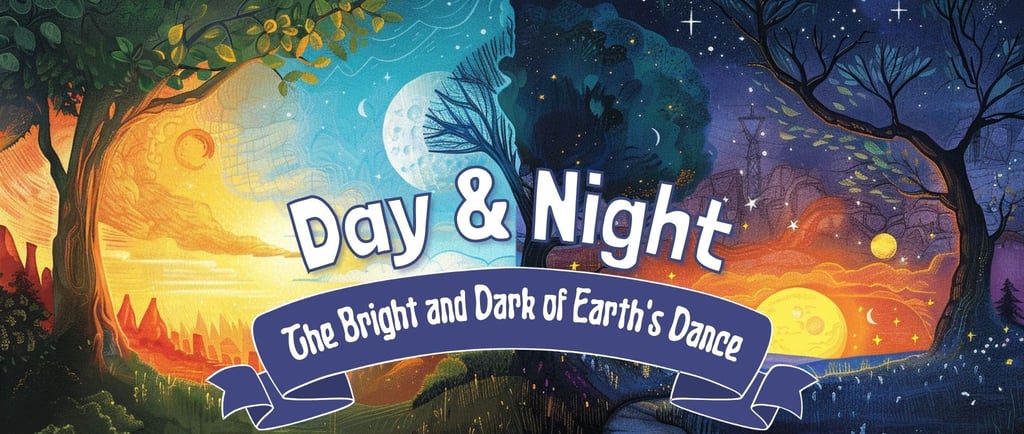The Importance of Day and Night Educational Videos for Enhanced Learning
11/11/20253 min read


🌞 Day and Night: The Bright and Dark of Earth’s Dance 🌜
Helping Children Understand the Magic of Earth’s Rotation
Have you ever watched your child stare out of the window at sunset, their eyes wide with wonder, and asked, “Where does the Sun go when it’s dark?”
It’s one of those beautiful, timeless questions that every child asks — and it opens the door to one of the most fascinating lessons about our planet: the dance between day and night.
🌍 The Spinning Secret of Our Planet
Every single day, Earth performs a graceful spin, rotating once on its axis every 24 hours. This gentle, steady motion is what creates daytime and nighttime — a rhythm that guides not just our routines, but the lives of plants, animals, and people everywhere.
When the part of Earth you live on faces the Sun, it’s daytime. The light warms the land, fills the skies with color, and gives us the perfect conditions to play, learn, and grow.
As Earth continues to turn, that same place slowly moves out of the Sun’s reach — and darkness begins to fall. That’s when we say goodnight to the bright sky and hello to the stars.
✨ A Story Hidden in the Sky
For children, the concept of a spinning Earth can feel a bit abstract. After all, we don’t feel the movement. But through stories, visuals, and imagination, it becomes something magical.
In Day & Night: The Bright and Dark of Earth’s Dance, we bring this cosmic idea down to Earth — literally — showing young readers how their world transforms from golden sunshine to silvery moonlight as our planet twirls through space.
The vibrant illustrations show cities bathed in daylight and forests glowing under the moon, helping children grasp the pattern that repeats every 24 hours.
🦉 Nature’s Night Owls and Daytime Flyers
Another fascinating aspect of day and night is how different creatures prefer different times to be active.
Owls, bats, and foxes come alive under the stars, using their special night vision to hunt and explore. Birds, butterflies, and bees, on the other hand, thrive in the sunlight, filling the world with color and song.
Teaching children about these patterns not only deepens their understanding of the natural world — it encourages empathy, curiosity, and a love of science.
☀️ Turning Science Into Wonder
Science doesn’t have to be complicated. When we tell stories about how our planet moves, shines, and rests, children don’t just learn facts — they feel them.
They begin to notice the world differently: the length of shadows, the changing colors of the sky, and the steady rhythm that makes every sunrise and sunset unique.
Day & Night help bridge that gap between scientific explanation and emotional connection. They spark a sense of awe — a reminder that what seems ordinary, like the rising and setting of the Sun, is actually quite extraordinary.
🌿 Learning Beyond the Page
Here are a few fun ways parents and teachers can bring the lesson of day and night to life:
Shadow tracking: Use a stick in the ground and mark its shadow every hour to see how it moves.
Sunrise journal: Encourage children to sketch or describe what they see at different times of the day.
Star gazing: On a clear night, step outside together and spot constellations — the stars that only appear when Earth turns away from the Sun.
Animal activity chart: Create a fun list of “day animals” and “night animals” to compare their habits.
Each activity helps children connect science with real-world experiences, turning curiosity into understanding.
🌏 Why Day and Night Matter
Understanding the rhythm of day and night is more than a science lesson — it’s a foundation for appreciating how our planet works in harmony. It teaches children patience, cycles, and the importance of balance — lessons that go far beyond astronomy.
So next time your child gazes up at the sunset or wonders where the moon hides during the day, you can share the simple truth:
Our world is always dancing — spinning gently through space, giving us both light and rest, brightness and mystery.
📖 Explore More
If you’d like to introduce your little learner to this magical idea through story and art, explore our video:
🪐 Day & Night: The Bright and Dark of Earth’s Dance
It’s a beautifully illustrated journey that brings science to life — one sunrise, sunset, and starry sky at a time.